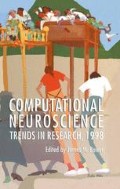Abstract
The fundamental questions of sensory neuroscience are how neurons encode information and how neurons extract (process) information. For example, in the auditory system, sound location is determined by a combination of amplitude and time cues. The Lateral Superior Olive (LSO), one of the first nuclei to receive inputs from both ears, is thought to extract high-frequency localization information based on interaural level difference (ILD) and interaural time difference (ITD) cues. However, while the optimal localization processing system produces the same response for the same ILD regardless of source level,1 LSO responses are affected by source level.2 This sensitivity questions the presumption that the LSO is strictly an angle processor, and suggests that the LSO may be coding other stimulus features such as sound level. We have used a new analysis technique to analyze the significance of the LSO sensitivity to sound level compared to that of an optimal angle processor. We also examined the processing of two features: azimuthal angle and source level by the LSO network by comparing the response sensitivity of network inputs with that of its outputs.
Access this chapter
Tax calculation will be finalised at checkout
Purchases are for personal use only
Preview
Unable to display preview. Download preview PDF.
References
D. H. Johnson, A. Dabak, and C. Tsuchitani. Function-based modeling of binaural interactions: Interaural level, Hearing Research, 49: 301–320, 1990.
C. Tsuchitani. The inhibition of cat lateral superior olivary unit excitatory response to binaural tone bursts: I. The transient chopper discharges. Journal of Neurophysiology, 59: 164–183, 1988.
T. M. Cover and J. A. Thomas. “Elements of Information Theory,” John Wiley & Sons, New York (1991).
F. Gabbiani, W. Metzner, and C. Koch. From stimulus encoding to feature extraction in weakly electric fish, Nature 384: 564–567 (1996).
D. H. Johnson and C. M. Gruner. Neural Ensemble Processing with Types, in: “Computational Neuroscience, Trends in research 1998” (this volume).
M. Zacksenhouse, D. H. Johnson, J. Williams, and C. Tsuchitani. Single-neuron modeling of LSO unit responses, Journal of Neurophysiology to appear, (1998).
R. B. Stein. The information capacity of nerve cells using a frequency code, Biophysical Journal 7: 797–826 (1967).
Author information
Authors and Affiliations
Editor information
Editors and Affiliations
Rights and permissions
Copyright information
© 1998 Springer Science+Business Media New York
About this chapter
Cite this chapter
Gruner, C.M., Johnson, D.H. (1998). Analysis of Sensory Coding in the Lateral Superior Olive. In: Bower, J.M. (eds) Computational Neuroscience. Springer, Boston, MA. https://doi.org/10.1007/978-1-4615-4831-7_30
Download citation
DOI: https://doi.org/10.1007/978-1-4615-4831-7_30
Publisher Name: Springer, Boston, MA
Print ISBN: 978-1-4613-7190-8
Online ISBN: 978-1-4615-4831-7
eBook Packages: Springer Book Archive

